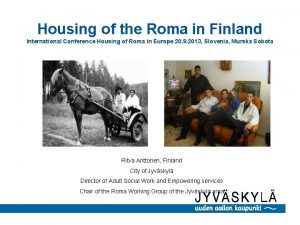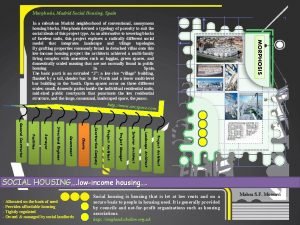Roma housing and mainstream social housing policy in















- Slides: 15

Roma housing and mainstream social housing policy in Bulgaria Cases and patterns from Bulgaria Boyan Zahariev Open Society Institute - Sofia Budapest 13/09/2013

Social housing policy – the situation in Bulgaria Practically no social housing – less than 3% of the total housing stock Increased migration from villages to cities and away from depressed regions – consequence of failed regional development policies and the works of unregulated markets A lot of poor quality housing (a time bomb) – prefabricated blocks of flats built during communism are coming close to the end of their life. Some located in Roma ghettoes have already been demolished. 2

The three locations Kystendil – South-West Bulgaria, 45 thousand, one big Roma ghetto Dupnitsa – South-West Bulgaria, 34 thousand, at least five Roma neighbourhoods Sofia – West Bulgaria, 1. 3 milllion population, three of the biggest Roma neighbourhoods in Bulgaria and an unknown number of locations with illegal and extremely substandard (inhabited) housing 3

The case of Kyustendil – good sides A successful but very limited and probably not replicable case of social housing (Kyustendil) A risky mainstream social housing project funded by ERDF, which is still work in progress (Dupnitsa) Where does housing deprivation come from (examples from the capital city)? 4

The case of Kyustendil – good sides Quite successful – housing is maintained and does not deteriorate, utility bills are regularly paid, neighborhood relations are well managed and conflict-free Small semi detached houses, close the usual pattern of inhabiting of the Roma in Kyustendil. 5

The case of Kyustendil - deficiencies A bit of social work, but not much support for employment, no additional income support The project is hardly replicable beyond the specific protestant community It covers a very small proportion of the needy who are generally not the neediest. 6

The town of Dupnitsa – work in progress Work in progress, a project funded from the ERDF. Small 2 -3 floor condominiums with a total of 150 flats Low cost subsidized rent But the rent is not the main problem… 7

Utility bills are 8

Due to overindebtedness and inability to make end meet 9

Combined with inability to maintain the existing housing 10

New (small but growing) ghettoes are emerging (the spots of illegal accommodations in Sofia are shown on the map) 11

There are “hotspots” attracting the poor who move around looking for opportunities to have a decent life 12

The hotspots include Places where other poor people and homeless people live Places with existing poor and illegal housing Abandoned industrial property Poorly maintained and rarely used public spaces Servitude areas of the transport and technical infrastructure 13

Housing deprivation persists because Accommodations deteriorate and get dilapidated with time, especially when not properly maintained Accommodations built by or inhabited by poorer people tend to be less durable and more poorly maintained People die, new people are born. Among poorer groups population growth is faster. Some Roma groups follow traditional family patterns, prefer to live close to each other People move (in communists times movement was administratively restricted to keep negative consequences from unbalanced development at bay. In the last 20 years people move a lot. 14

Conclusions Housing deprivation is not just a matter of finding a solution for a list of existing places or for a list of existing households It is a matter of unbridled economic and social forces which produce and replicate housing deprivation 15
 Reverse mainstream
Reverse mainstream Mainstream programming languages
Mainstream programming languages Mainstream flights
Mainstream flights Mainstream vs counterculture
Mainstream vs counterculture Mainstream smoke
Mainstream smoke Sidestream smoke
Sidestream smoke Supported housing roma
Supported housing roma Social thinking social influence social relations
Social thinking social influence social relations Social thinking social influence social relations
Social thinking social influence social relations Social housing decarbonisation fund demonstrator
Social housing decarbonisation fund demonstrator Madrid social housing morphosis
Madrid social housing morphosis Social housing canada
Social housing canada Valuing land for social housing
Valuing land for social housing Stateline shrm
Stateline shrm Ncaa social media rules
Ncaa social media rules 2nd social welfare policy in pakistan
2nd social welfare policy in pakistan





























